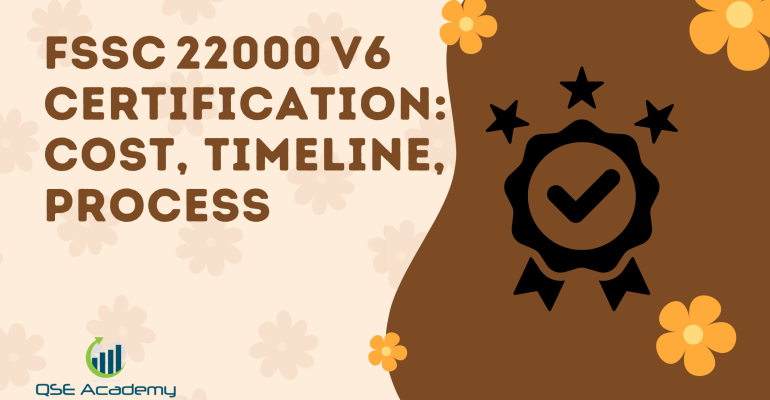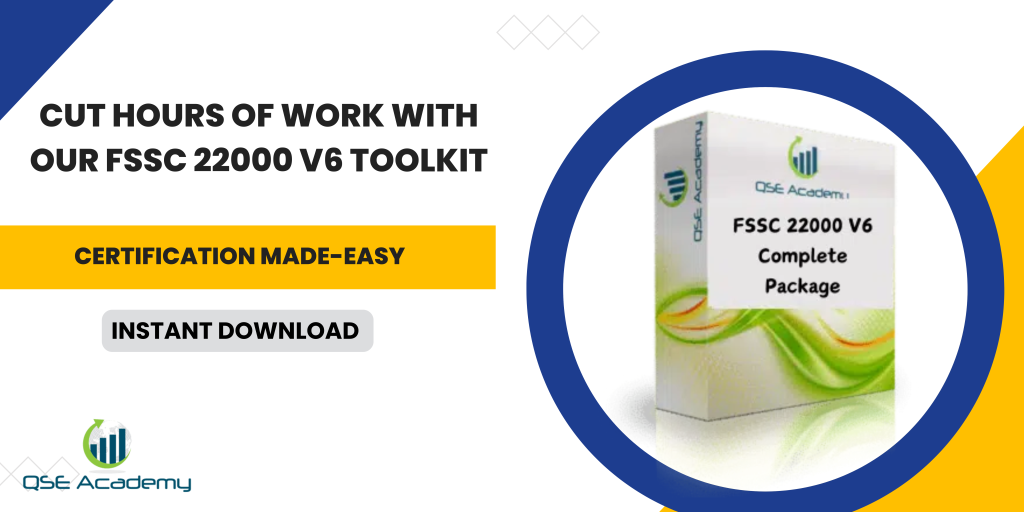FSSC 22000 V6 Certification: Cost, Timeline, Process
A Complete Roadmap to FSSC 22000 V6 Certification
If you’re exploring FSSC 22000 V6 certification, you’re likely looking for clarity on three things:
- How much will it cost?
- How long will it take?
- What’s the exact process from start to finish?
These questions come up in nearly every conversation with food businesses preparing for certification. After supporting hundreds of companies across manufacturing, packaging, distribution, and food logistics, I’ve seen one consistent truth: certification becomes easier when you understand the roadmap upfront.
This guide brings everything together — the cost structure, the certification steps, realistic timelines, and what happens after certification. The goal is simple: help you plan confidently, avoid unnecessary delays, and build a certification approach that’s predictable and structured.
Understanding the FSSC 22000 V6 Framework
Before diving into cost and timelines, it’s important to understand what FSSC 22000 V6 includes.
It’s built on three core components:
- ISO 22000:2018 – The base Food Safety Management System (FSMS).
- ISO/TS 22002-series PRPs – Depending on your sector (e.g., manufacturing, catering, packaging).
- FSSC Additional Requirements – Food-defense, allergen management, environmental monitoring, food-safety culture, and more.
The scheme is GFSI-recognized, which means it meets international buyer and retailer expectations.
A quick note worth emphasizing: Version 6 introduced new focus areas including food-safety culture maturity, expanded allergen control, and measurable environmental monitoring programs. These changes must be fully implemented before your audit.
 Certification Cost Explained: Where the Investment Goes
Certification Cost Explained: Where the Investment Goes
Certification pricing isn’t random. It follows structured criteria set by industry rules, and certification bodies calculate their fees using internationally recognized guidelines like IAF MD 5 for man-day durations.
Most organizations will see cost components fall into these categories:
- Audit man-days (Stage 1 and Stage 2)
- Technical review and certificate issuance fees
- Travel and accommodation for auditors
- Annual surveillance audits
- Recertification audit at the end of Year 3
Your pricing is influenced by factors such as:
- Number of employees
- Scope of processes
- Food-chain category
- Number of sites
- Whether processes are high or low risk
A small facility with 25 employees and one production line will not require the same audit effort as a multi-site cold-chain logistics network.
Pro Tip: Request quotations that clearly separate audit days, fees, expenses, and annual costs. It prevents surprises later and helps align your budget with long-term planning rather than just the first year.
The FSSC 22000 V6 Certification Process
The certification process follows a logical sequence. Each step builds on the previous one to ensure readiness and compliance before the certification body arrives.
1. Gap Analysis and Feasibility Review
You compare your current food-safety program against FSSC 22000 V6 requirements, identify gaps, and create a realistic roadmap.
Output: Action plan, resource allocation, and implementation timeline.
2. System Development and Implementation
Documents, procedures, monitoring programs, and operational controls are created or updated.
Key components include:
- PRPs aligned with ISO/TS 22002
- Validated HACCP plan
- Documented food-safety culture initiatives
- Supplier control programs
- Recall and traceability systems
Training and competency building happen throughout this stage.
3. Internal Audit and Management Review
These activities confirm that the system works — not just in documentation, but in daily practice.
Auditors expect evidence that leadership, monitoring, and improvement activities are happening consistently.
4. Stage 1 Audit (Readiness Assessment)
A certification auditor reviews your documentation, confirms legal compliance, and checks if you’re ready for Stage 2.
It typically lasts 1–2 man-days.
5. Stage 2 Audit (Certification Audit)
This is the full operational audit where the auditor assesses process control, implementation, staff competence, monitoring, traceability, and evidence of compliance.
Duration depends on your organization size, risk category, and scope.
6. Certification Decision and Audit Cycle Enrollment
Once corrective actions are submitted and accepted, the certification body issues your certificate and places you into the three-year certification cycle.
How Long Certification Takes
For most small or medium food businesses, certification takes approximately:
| Stage | Estimated Timeline |
|---|---|
| Gap Analysis | Weeks 1-2 |
| Implementation | Weeks 3-10 |
| Internal Audit & Management Review | Weeks 11-13 |
| Stage 1 Audit | Week 14 |
| Stage 2 Audit | Weeks 15-17 |
| Certification Decision | Weeks 18-20 |
Organizations with strong existing systems can move faster. Larger or complex operations may require additional months.
Pro Tip: Running documentation development and staff training in parallel shortens the implementation stage significantly.
Audit Duration: How Man-Days Are Calculated
The number of audit days directly impacts both your timeline and cost. Certification bodies calculate audit duration using:
- Number of employees (including seasonal labor)
- Shifts and operating hours
- Category risk level
- Multi-site structure
- Integration with other standards (e.g., ISO 9001)
Audit duration is not negotiable below the minimum set by accreditation rules, but reductions may apply if multiple standards are audited together.
Choosing the Right Certification Body
Selecting your certification partner is an essential decision.
Key evaluation points include:
- Accreditation validity for FSSC 22000 V6
- Sector-specific auditor competence
- Quote transparency and fee structure
- Responsiveness during the inquiry stage
- Recognition and acceptance within your supply chain
Only certification bodies listed on the official FSSC Foundation database are authorized to issue certificates.
Maintaining Certification: Surveillance and Recertification
Certification continues beyond the Stage 2 audit.
You’ll undergo:
- Year 1 Surveillance Audit
- Year 2 Surveillance Audit
- Year 3 Recertification Audit
Auditors verify:
- Evidence of continual improvement
- Corrective-action effectiveness
- Monitoring records
- Updated hazard analyses
- Food-safety culture activities
Maintaining readiness all year — not just before audit week — keeps the certification cycle consistent and predictable.
A Real-World Insight from Industry Experience
One mid-size beverage manufacturer completed certification in just under five months. Their success came from structuring implementation around roles rather than departments, ensuring accountability at every step. When the audit occurred, the system wasn’t just compliant — it was well understood by the team.
FAQs
How much does certification cost?
Most organizations should expect a multi-year investment that depends on audit-day requirements, region, and scope.
How long does certification take?
For most SMEs, the process typically takes 4–6 months.
Can certification bodies be changed later?
Yes — transfers are allowed through defined rules managed by the new certification body.
Closing Summary
FSSC 22000 V6 certification becomes far more manageable when you understand the full picture — cost drivers, timelines, audit structure, and what’s expected after certification. When planning with the full three-year cycle in mind, the process shifts from being a project to becoming part of ongoing operational excellence.
If you approach it with structure, clarity, and realistic planning, certification becomes less about uncertainty and more about building a reliable food-safety system that meets global expectations and supports long-term growth.
Melissa Lavaro is a seasoned ISO consultant and an enthusiastic advocate for quality management standards. With a rich experience in conducting audits and providing consultancy services, Melissa specializes in helping organizations implement and adapt to ISO standards. Her passion for quality management is evident in her hands-on approach and deep understanding of the regulatory frameworks. Melissa’s expertise and energetic commitment make her a sought-after consultant, dedicated to elevating organizational compliance and performance through practical, insightful guidance.








